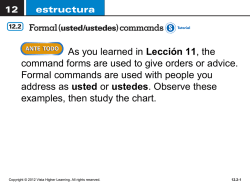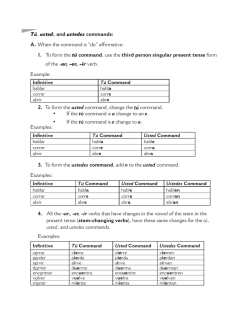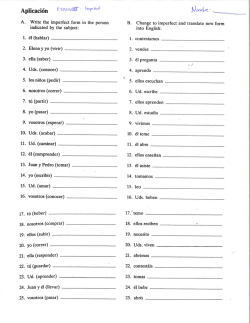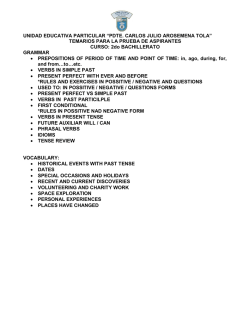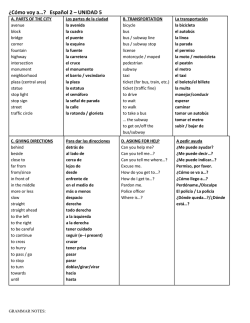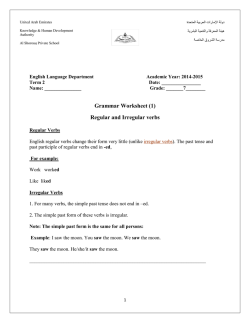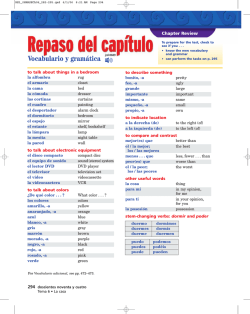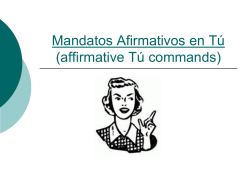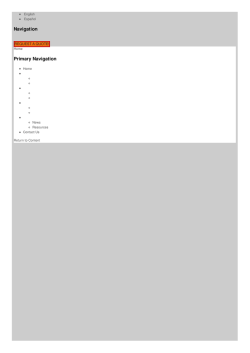
Decir: diciendo: saying Servir: sirviendo: serving Yo estoy repitiendo
ANSWER KEY Realidades 2: Capítulo 3B: ¿Cómo se va…? REVIEW PACKET Present Progressive: To say that an action is happening right now, use the present progressive. To form the present progressive, use the present tense of estar + the present participle: -ando (doblar = doblando = turning) or –iendo (aprender = aprendiendo = learning). Some verbs have irregular present participle forms. To form the present participle of -IR stem changing verbs, the e in the infinitive form changes to i, and the o in the infinitive forms changes to u. diciendo: saying Repetir: repitiendo: repeating Servir: sirviendo: serving Vestir: vistiendo: dressing pidiendo: asking for/ordering Seguir: siguiendo: following / continuing Dormir: durmiendo: sleeping Decir: Pedir: Spelling changes: In the following -ER verbs, the i of iendo changes to y: creyendo: believing Leer: leyendo: reading trayendo: bringing Oír: oyendo: hearing Creer: Traer: A. Translate into Spanish: Yo estoy repitiendo las palabras. You are asking for help. Tú estás pidiendo ayuda. She is following a car. Ella está siguiendo al carro (coche). He is serving food. Él está sirviendo la comida. We are dressing the doll (la muñeca). Nosotros estamos vistiendo la muñeca. They are sleeping. Ellos están durmiendo. I am reading the vocabulary. Yo estoy leyendo el vocabulario. You are bringing food. Tú estás trayendo la comida. 1. I am repeating the words. 2. 3. 4. 5. 6. 7. 8. B. Say what the following people are doing now that is different from what they normally do. Follow the model. Model: Generalmente, Juan maneja despacio. Ahora él está manejando rápido 1. Normalmente, Diego dice mentiras (lies). Ahora él está diciendo la verdad (the truth). 2. Cada día los peatones no siguen por aquella avenida. Hoy sí ellos están siguiendo por aquella avenida. ANSWER KEY 3. Generalmente, repetimos las direcciones cuando las recibimos. Ahora no estamos repitiendo nada. 4. Normalmente, Uds. leen el manual de manejar. Ahora Uds. no ellos están leyendo el manual. 5. Liliana cruza la calle con su mamá todos los días. Pero ahora no ella está cruzando la calle porque está sola (by herself). 6. Siempre traigo mi permiso de manejar. Hoy no estoy trayendo el permiso conmigo. 7. Normalmente me pones tranquilo. Ahora me estás poniendo nervioso. 8. Generalmente, Andrés duerme en casa. No sé por qué ahora está durmiendo en el coche. 9. En este restaurante siempre pedimos la paella. Pero esta noche estámos pidiendo la tortilla española Direct object pronouns replace direct object nouns. The direct object pronoun lo, la, los, and las can refer to both objects and people. The pronouns me, te, nos, and os refer only to people. Write the direct object pronouns: Singular Me me You familiar Plural Us te Him, it, you formal Her, it, you formal nos You familiar Spain lo la Them (f) os las los Them (m) You formal C. Rewrite the sentences using a direct object pronoun. 1. Tomás mira a Elena. Tomás la mira. (Tomás looks at her.) 2. Juan tiene las fotos. Juan las tiene. / Él las tiene. 3. La madre acuesta al niño. La madre lo acuesta. / Ella lo acuesta. 4. Ellos visitan a nosotros. Ellos nos visita. 5. Ella invita a mí a la fiesta. Ella me invita a la fiesta. 6. Él ayuda a ti con la tarea. Él te ayuda con la tarea. ANSWER KEY D. Complete the following exchanges with the missing direct object pronouns. Follow the model. Model: —¿No ves que estoy aquí? (Don’t you see that I’m here?) —No, no _te__ veo. (No, I don’t see you.) 1. —¿Ya tienes el permiso de manejar? Do you have your driver’s license? lo —Sí, ya tengo. Yes, I have it. 2. —Laura, Elena, ¿quieren ustedes venir a mi fiesta esta noche? Do you guys want to come to my party? nos —Sí. invitaste la semana pasada. Yes, you invites us. 3. —Termino el trabajo a las seis. Luego voy a tu casa. I finish work at 6. Then, I’ll go to your house. te —Bueno, espero (wait) en mi casa a las seis y media. OK. I’ll wait for you at my house at 6:30PM 4. —¿Tienen ustedes problemas con la tarea? You you guys have problems with the homework? nos —Sí, ¿puedes ayudar esta noche? Yes, can you help us tonight? 5. —¿Sabes que vamos a jugar al fútbol el sábado? Do you know that we are going to play soccer? me —Sí, Martín habló por teléfono anoche. Yes, Martin, called me on the phone last night. 6. —Tengo que ir al estadio pero no tengo un coche. I have to go to the stadium but I don’t have a car. —No te preocupes (Don’t worry), Luis. Creo que Manolo te puede llevar. I think Manolo can take you. Me conoces a mí? Me llamo Julio. Do you know me? My name is Julio. —No, no te conozco. No, I do not know you. 7. —¿ Commands: When you tell friends, family members, or young people to do something you use an affirmative tú command. To give these commands, Start with the tú form and drop the ‘s’. Infinitve Hablar Leer Escribir Tú form hablas lees escribes Affirmative tú command habla lee escribe Negative tú commands is used to tell friends, family members, or young people what not to do. Negative tú commands is formed by using the present tense yo form as the stem, dropping the o, and adding the appropriate ending. Negative tú command of -AR verbs = es Infinitve hacer repetir tener Negative tú command of -ER and -IR verbs = as Yo form hago repito tengo Negative tú command no hagas no repitas no tengas ANSWER KEY Infinitive Affirmative tú commands dormir Negative tú commands duerme corre dobla Correr doblar no duermas no corras no dobles Use formal commands when addressing people you do not know well, people older than you, or people that you generally show respect. Affirmative and negative usted and ustedes commands are formed by using the present tense yo form as the stem, dropping the o, and adding the appropriate ending. Usted command of -AR verbs = e Ustedes command of - AR verbs = en Usted command of -ER and -IR verbs = a Ustedes command of -ER and -IR verbs = an Infinitive seguir traer escribir Ud (+) commands sigue traiga escriba Ud (-) commands no siga no traiga no escriba Uds (+) commands sigan traigan escriban Uds (-) commands no sigan no traigan no escriban Familiar positive Tú commands you must memorize: ven say/tell di sal do/make haz pon be sé Negative tú; positive and negative Ud, Uds commands you must memorize: go vaya come leave/get out ten go ve have put E. Write the affirmative (positive) tú and Ud. command forms of the verbs to complete the commands. Verb sé (poner) pon (venir) ven (ir) ve (decir) di (hacer) haz (salir) sal (tener) ten 1. (ser) 2. 3. 4. 5. 6. 7. 8. tú Ud. sea un buen estudiante. ponga los libros en el carro. venga conmigo a la farmacia. vaya a pie a la escuela. diga la verdad. haga la tarea enseguida. salga de aquí inmediatamente. tenga cuidado.
© Copyright 2025
